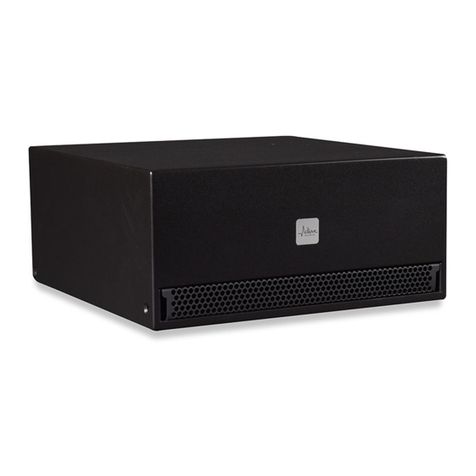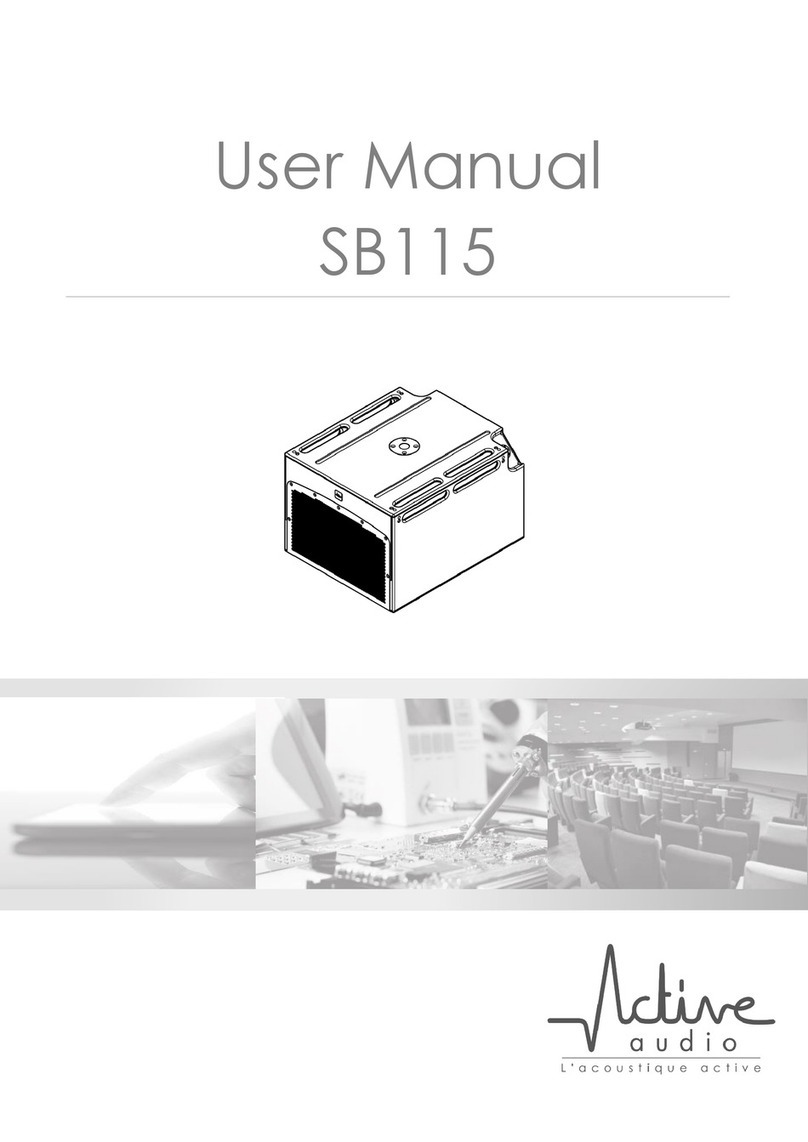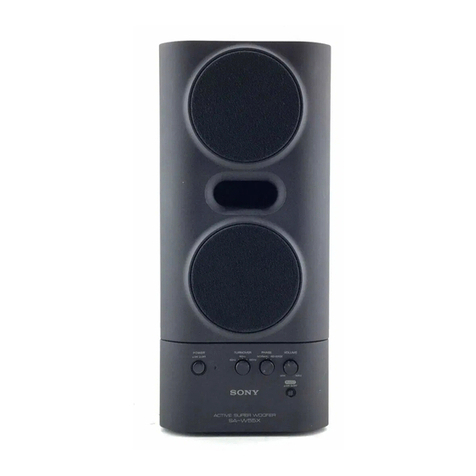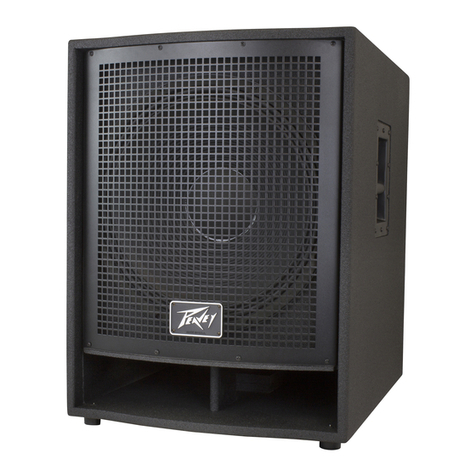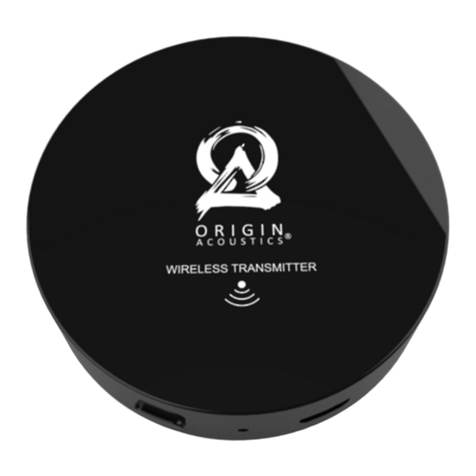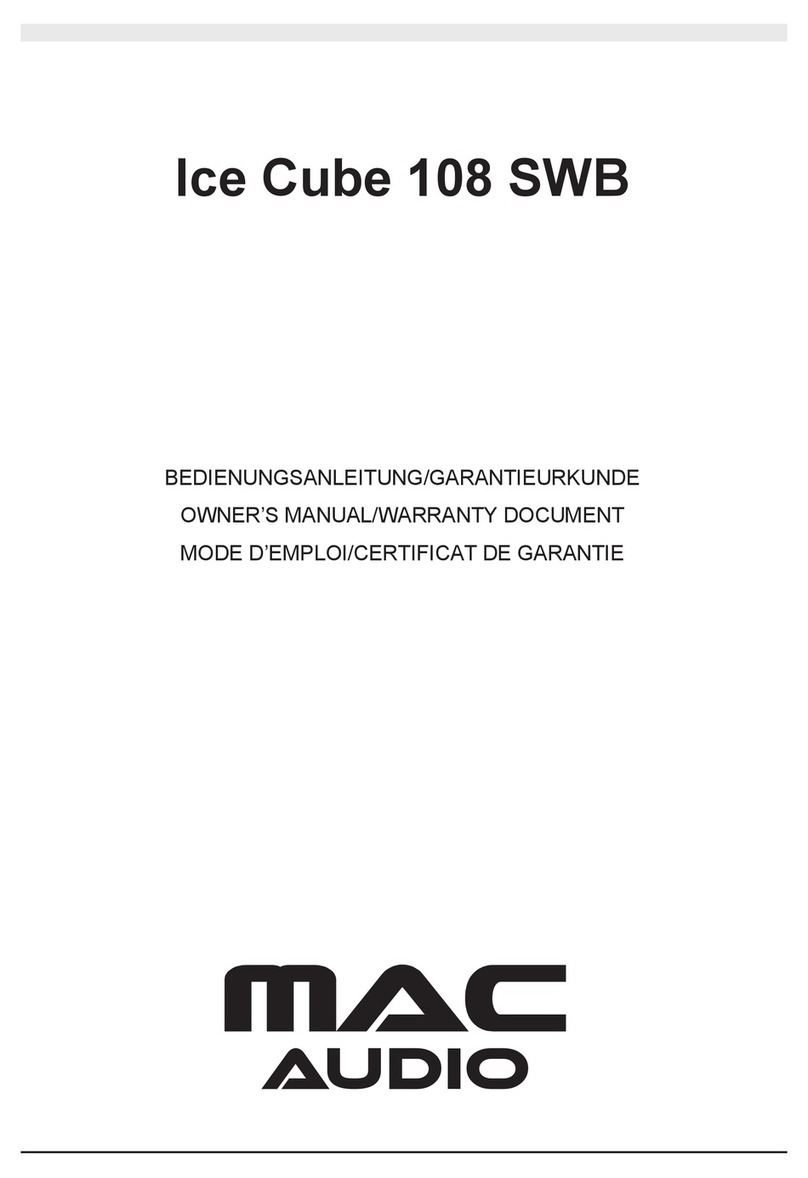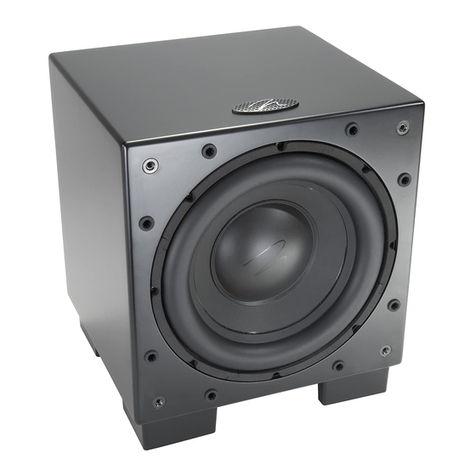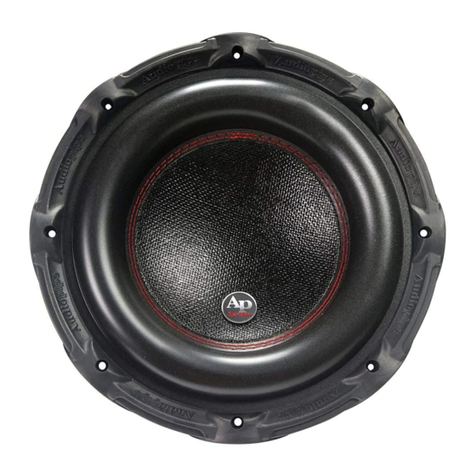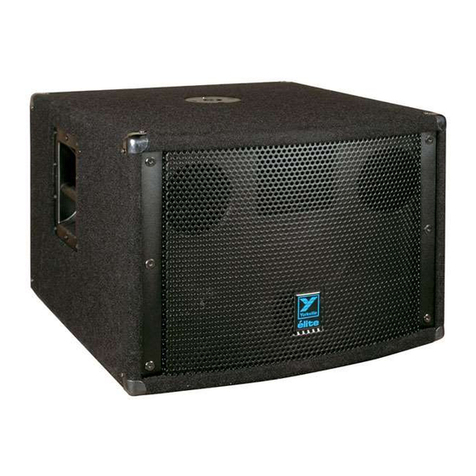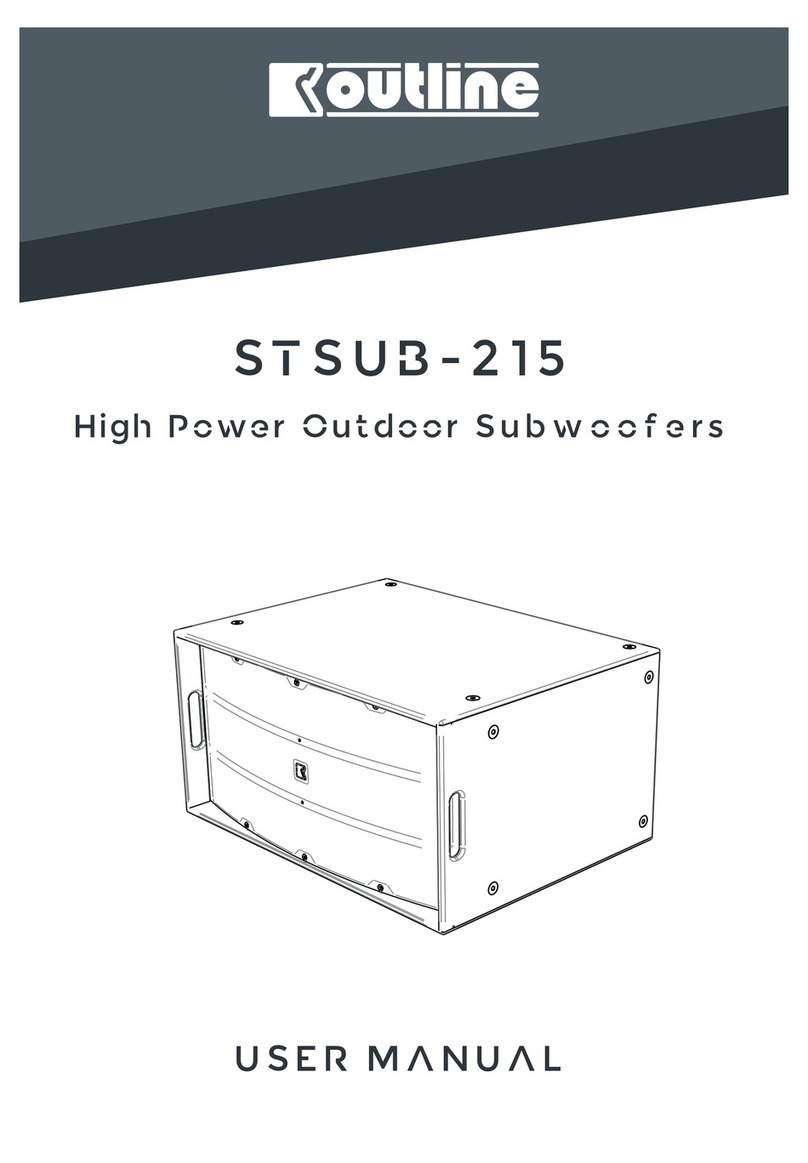Active Audio SB110 User manual

L'acoustique active
User Manual
SB110

2/16ver. 2017/06/19
User Manual - SB110

3/16 ver. 2017/06/19
User Manual - SB110
Table des matières
1. Introduction...............................................................................5
2. Requirements and installation......................................................6
3. Wiring .......................................................................................7
4. Filtering and settings in NUT .......................................................8
4.1. Recommended equalization ...................................................8
4.2. Excursion limitation ...............................................................9
4.3. NUT Processor settings........................................................ 10
5. Technical data..........................................................................13
6. Warranty .................................................................................14
7. Troubleshooting .......................................................................14
8. Declaration of conformity..........................................................15

4/16ver. 2017/06/19
User Manual - SB110

5/16 ver. 2017/06/19
User Manual - SB110
1. Introduction
The SB110 subwoofer is designed to extend the bass response of column louds-
peakers such as StepArray or Ray-On. It is passive, has no lter, and therefore
requires ltering upstream of the amplier.
SB110 is very compact, and can be positioned both horizontally and vertically
for optimal visual integration.
The high-end 10-inch loudspeaker is loaded with an enclosure operating in
interactive dual volume mode. It achieves a remarkably low cutoff in a small
volume, while yielding sharp and dynamic sound.
The NUT processor comprises modules for managing subwoofers, with presets
corresponding to the SB110.
The SB110 also exist in 70/100V version under the reference SB110T.
Applications
Background and foreground music, audio-visual programs, small live, in :
• Meeting and conference rooms
• Amphitheaters
• Places of worship
• …

6/16ver. 2017/06/19
User Manual - SB110
2. Requirements and installation
We recommend that the SB110 be positioned far enough away from the au-
dience, so that the sound coverage is uniform over the entire audience. The dis-
tance separating the SB110 from the closest listeners must be greater than the
reverberation distance. Thus, practically speaking, the SB110 must be placed at
least 3 meters from the closest audience members. The SB110 can be placed
to the ceiling to if necessary.
In terms of maximum sound level, the SB110 is designed to be aligned with Ste-
pArray and Ray-On column loudspeakers. To maximize the power of the column
loudspeakers, we recommend:
• as many SB110 as there are SA180, SA250, R200
• 1 SB110 for 2 SA100 or 2 Ray-On R100
When several SB110 are used to deliver the same signal, theoretically 3dB ef-
ciency and SPL may be gained by positioning them together (e.g. side by side or
one on top of the other). The maximum sound level obtained with two adjacent
SB110s will then be 6dB greater than that obtained with a single SB110. On the
other hand, the sound coverage may be more uniform if they are distributed
around the room.
The SB110T is equipped with a 100V line transformer with a power of 100W.
Its maximum sound level is therefore lower than that of the SB110 (about 8dB
less). The low cutoff of the transformer is 35Hz.
The SB110 can be placed horizontally on the oor, or vertically against a wall
using the accessory SB110_KMV (Figure 1).
Figure 1 :
Mounting the SB110 vertically with the accessory SB110_KMV

7/16 ver. 2017/06/19
User Manual - SB110
3. Wiring
For SB110, use 2 x 1.5 mm² cable when the distance between the amplier and
the SB110 is less than 50 m; 2 x 2.5 mm² for greater distances.
For SB110T, use a 2 x 0.75 mm² cable (minimum).
The SB110 / SB110T connector can be used to connect several subwoofers in
daisy chain conguration as shown in Figure 2. This naturally presupposes that
a suitable amplier is used. Thus, for N subs connected to the amplierin a
daisy chain conguration:
• In 100V mode: Amplier power ≥ N x 100W,
• In low impedance mode: The amplier must withstand a load impedance
of 8/N Ohms, and must deliver sufcient maximum power.
SB110 #1 SB110 #2
Amp. -
+
Tableau 1 :
Connecting multiple SB110 or SB110T in a daisy chain
conguration

8/16ver. 2017/06/19
User Manual - SB110
4. Filtering and settings in NUT
4.1. Recommended equalization
Table 1 gives the recommended equalization and crossover settings for the
SB110 used with StepArray and Ray-On column loudspeakers. The correspon-
ding response curves are given in Figure 3.
Cell # Type Frequency (Hz) Gain (dB) Width (oct)
1 Low-pass - 2nd order 160 Hz -8 dB
2 Low-pass - 2nd order 180 Hz -1 dB
3 Low-pass - 2nd order 180 Hz -2 dB
4 High-pass - 2nd order 40 Hz -1 dB
5 High-pass - 2nd order 40 Hz -2 dB
6 Parametric 40 Hz +6 dB 0,3 oct
Tableau 2 :
Recommended equalization when using the SB110 with StepArray
and Ray-On loudspeakers
100 1k
60
70
80
90
100
110 20
10
0
-10
-30
-20
50050 20020 2k 4k
dB SPL - 1m - 2.83V
Freq.Hz
Equalization (dB)
100 1k
0
5
10
15
20
25
30
35
40
45
50
50050 20020 2k 4k 8k
Ohms
Freq.Hz
Figure 2 :
Curves corresponding to the equalization in Table 1 (in blue, right-
hand scale); response curve of the SB110 in ½ spaces with this equalization
(in red, left-hand scale)

9/16 ver. 2017/06/19
User Manual - SB110
4.2. Excursion limitation
High-amplitude signals with very low frequencies
cause large membrane excursion. Excessive excur-
sion causes harmonic distortion, which degrades the
sound quality and causes a risk of damage to the
loudspeaker.
It is desirable to limit the amplitude of the deections either by reducing the
amplitude of the applied signal or by placing a high-pass lter upstream of the
amplier, for example, a second order Butterworth lter at 80Hz.

10/16ver. 2017/06/19
User Manual - SB110
4.3. NUT Processor settings
The following paragraphs describe the steps involved in setting up an installa-
tion using an SB110 and a NUT processor. It is of course possible to use other
processors. Under these circumstances, the settings below must be transposed
for the processor used.
Step 1 : Group the SUB channel with the main channel: To do this, assign
these two channels to a single group (Figure 4). The levels of the SB110 and the
high channel (here SA250P) are thus controlled by the group gain.
Figure 3 :
The SA250P and SB110 outputs are assigned to group B in the Vo-
lume settings block. The grouping of the outputs is also displayed on the right
of the main screen (right)
Group selection
Group gain
Group ID

11/16 ver. 2017/06/19
User Manual - SB110
Step 2 : In the equalizer of the SB110 channel, select the desired setting. For
example, «SB110 subwoofer» (Figure 5). The lter thus selected includes the
equalization recommended previously.
Figure 4 :
Selection of the equalizer and crossover lter for the SB110 opera-
ting with StepArray or Ray-On
Step 3 : In the equalizer of the main channel, select the desired setting. For
example, «StepArray with SB110 subwoofer», or «Ray-On with SB110 subwoo-
fer» (Figure 6).
Figure 5 :
Selection of the high-pass crossover lter for the main channel

12/16ver. 2017/06/19
User Manual - SB110
Step 4 : In the «Volume Settings» window, set the relative levels of both
channels. For example -7dB for the main channel and 0dB for the SB110 chan-
nel (Figure 7). The gain difference (in dB) of the two channels depends of
course on the gain difference of the amps used for the main channel and the
SB110 channel. The easiest way to adjust these gains is to use a sound level
meter.
Figure 6 :
Adjusting the gains of the main channel and the SB110 channel in
the «Volume settings» block (arrows)
Gain voie SB110
Gain voie principale

13/16 ver. 2017/06/19
User Manual - SB110
5. Technical data
Acoustical SB110 SB110T
Loudspeaker 10’’ neodyme
Load type Interactive dual chamber
Long-term power1300W 100W
Sensitivity295.5dBSPL/1W/1m
Low-cut frequency2
High-cut frequency2
37Hz at -10dB, 43Hz at -3dB
215Hz at -10dB, 180Hz at -3dB
Directivity Omnidirectional
Max continuous sound level at 1m3119dBSPL 111dBSPL
Nominal impedance 8Ω 100Ω
Recommended amplier
100W to 500W
depending on max
SPL
100V - 100W
Filtering
Equalization and connection 5x 2nd order cells
Physical
Dimensions 440 x 440 x 200mm
Volume 38.7 liters
Net / shipping weight 11.0kg / 12.0kg 12.3kg / 14.1kg
Color White (RAL9016), Black (RAL9005)
matte nish
Connection Euroblock with «daisy chain» output
Accessories
SB110_KMV Kit for vertical wall-mounting
1 : As per EN60268-5, with recommended EQ.
2 : With continuous pink noise, crossover at 180Hz and recommended EQ.
3: Noise as per EN60268-1, voltage corresponding to the long-term power, with recom-
mended EQ.

14/16ver. 2017/06/19
User Manual - SB110
6. Warranty
The SB110 has a 5-year warranty, in accordance with the General Conditions of
Sale. Malfunction problems must be reported to the manufacturer prior to any
return.
7. Troubleshooting
Symptom Possible causes Solution
The product
does not emit
any sound
Connector incorrectly
wired
No signal is sent
Check the connection
Check the source and the
amplier
The sound is
distorted
Excessive membrane
excursion
Decrease the bass level by
decreasing the gain and/
or adding a high-pass lter
(see above «Equalization»)
Presence of
unwanted vibra-
tions
Objects are vibrating
in the room due to the
effect of low frequen-
cies emitted by the
SB110.
Identify and secure the
objects that are vibrating.

15/16 ver. 2017/06/19
User Manual - SB110
8. Declaration of conformity
We,
ACTIVE AUDIO SAS,
332 Boulevard Marcel Paul 44800 St Herblain, France,
Declares under our sole responsability
that the following products
SB110, SB110T
complie with the council directive 2004/108/CE
Assessment of compliance is based on the following standards:
EN50081-1, EN61000, EN60065
Established on the 1st of June 2017
by Régis CAZIN, CEO.

www.activeaudio.fr
Active Audio SAS
332 Bd Marcel Paul, CP602
44806 Saint-Herblain Cedex - France
Phone: +33 (0)2 404 666 64
Contact
Other manuals for SB110
1
Table of contents
Other Active Audio Subwoofer manuals
